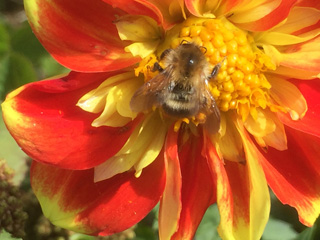 Well, what a month August has been. We took a 10 day holiday this month (we just needed to STOP! after how June and July had been) but before going I took off all the honey from the hives that had by that time (end of July, basically) been brought in. There was a better crop than I had expected and though I left empty supers on the hives in place of those taken away so the bees had space to congregate in, I did not expect any further nectar to be brought home and so no more honey. However, on returning home and checking the hives I found the bees were all working extremely busily, as you can see from the videos!
Well, what a month August has been. We took a 10 day holiday this month (we just needed to STOP! after how June and July had been) but before going I took off all the honey from the hives that had by that time (end of July, basically) been brought in. There was a better crop than I had expected and though I left empty supers on the hives in place of those taken away so the bees had space to congregate in, I did not expect any further nectar to be brought home and so no more honey. However, on returning home and checking the hives I found the bees were all working extremely busily, as you can see from the videos!
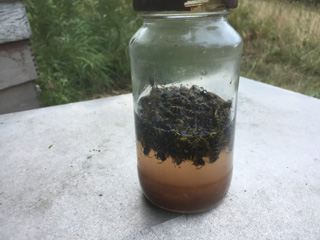 The thing is, I don’t know what they’re bringing in! Normally at this time of year there is a lull, when the bees have finished bringing in their summer crop and are (im)patiently waiting for the ivy flow to start. The only things that are usually around in August are basically solidago and asters, and whilst the solidago is almost over (in my garden) the asters are yet to flower. So, once the weather breaks finally, I shall find out. It might be that whatever is coming in now will go straight into the brood box to fill the empty cells left unlaid in by the queen, but without disturbing the bees I have no way of knowing. How exciting!
The thing is, I don’t know what they’re bringing in! Normally at this time of year there is a lull, when the bees have finished bringing in their summer crop and are (im)patiently waiting for the ivy flow to start. The only things that are usually around in August are basically solidago and asters, and whilst the solidago is almost over (in my garden) the asters are yet to flower. So, once the weather breaks finally, I shall find out. It might be that whatever is coming in now will go straight into the brood box to fill the empty cells left unlaid in by the queen, but without disturbing the bees I have no way of knowing. How exciting!
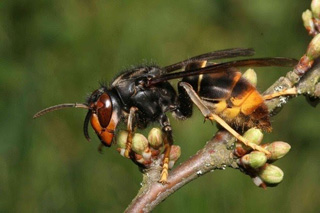 August is also the month when the wasps are at their most tiresome. They have been particularly numerous this year – I have two nests that I know of in my garden, one destroyed, the other in the process of being so. Yes, I know, wasps have their place in Nature’s scheme of things but they can totally destroy a colony of bees at this time of year. A fellow beekeeper has lost two colonies of his bees to wasps already this year.
August is also the month when the wasps are at their most tiresome. They have been particularly numerous this year – I have two nests that I know of in my garden, one destroyed, the other in the process of being so. Yes, I know, wasps have their place in Nature’s scheme of things but they can totally destroy a colony of bees at this time of year. A fellow beekeeper has lost two colonies of his bees to wasps already this year.
I try to control the level of predation by putting out wasp traps in the vicinity of the hives and this works very well. I use a jam jar with a small hole made in the lid (big enough to allow a wasp through) and fill it about a quarter full of water and then add a teaspoon of the cheapest jam I can buy. Swirled around and smeared over the edges of the hole prove a very attractive bait for wasps and the bees take no interest in it whatsoever.
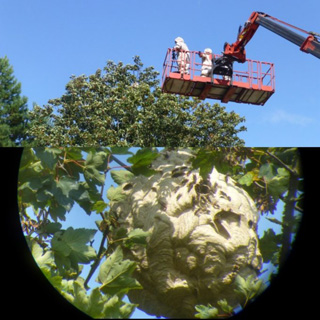 Time consuming – but very satisfying! I initially sprayed the nest twice with a foam containing insecticide but it’s impossible to reach the queen in the depths of a Cornish hedge, so the zapper came into its own as a way of reducing the population so that less or no queens can be produced by the colony.A new toy I have bought this year is an electronic swatter, like a tennis racket, which I have been using in the vicinity of my hives and at the entrance to one of the wasp colonies. I sit at the entrance to the nest with my swatter and catch returning wasps by pressing a button in the handle which activates the electricity in the mesh – and zap! No more wasp!
Time consuming – but very satisfying! I initially sprayed the nest twice with a foam containing insecticide but it’s impossible to reach the queen in the depths of a Cornish hedge, so the zapper came into its own as a way of reducing the population so that less or no queens can be produced by the colony.A new toy I have bought this year is an electronic swatter, like a tennis racket, which I have been using in the vicinity of my hives and at the entrance to one of the wasp colonies. I sit at the entrance to the nest with my swatter and catch returning wasps by pressing a button in the handle which activates the electricity in the mesh – and zap! No more wasp!
On a related topic, I bring you the Asian Hornet. This is the time of year when the Asian Hornets will become active in the apiary, hawking outside bee hives to catch returning foragers, biting off their heads and abdomens and taking the thorax back to the nest to feed their young. The early autumn is the last chance we will have to prevent the emergence of new Asian Hornet queens, so it has been decided to designate the week of 10-16 September as Asian Hornet Week to improve awareness of this exotic insect. The idea is that beekeepers will spend several one-hour sessions looking out for Asian Hornets in their apiaries so that we can leap into action should any be found. Life is difficult enough for our bees as things are at present – we can do without another reason for a reduction in our honey bee population.
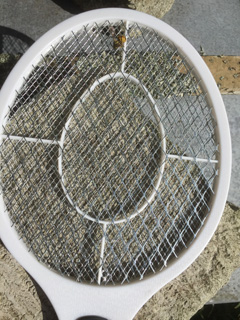 Members of the public can also be valuable in spotting these insects, particularly in identifying suspicious nests at height in the tops of trees. As ever, should you think you’ve seen an Asian Hornet, contact somebody who can help, it doesn’t matter who, but don’t ignore it hoping the problem will go away – they did that in France and they now have a huge problem which cannot be eliminated. Contact either myself or another beekeeper, DEFRA or the non-native species people at www.nonnativespecies.org. A photograph is desirable (though don’t put yourself at risk) or better still an actual sample (again, with care).
Members of the public can also be valuable in spotting these insects, particularly in identifying suspicious nests at height in the tops of trees. As ever, should you think you’ve seen an Asian Hornet, contact somebody who can help, it doesn’t matter who, but don’t ignore it hoping the problem will go away – they did that in France and they now have a huge problem which cannot be eliminated. Contact either myself or another beekeeper, DEFRA or the non-native species people at www.nonnativespecies.org. A photograph is desirable (though don’t put yourself at risk) or better still an actual sample (again, with care).
I shall be keeping an eye on my colonies over the next month, looking out for Asian Hornets and also ensuring the bees have enough food to see them through to the ivy flow. This latter is their mainstay over the winter months, so I’m hoping we get a better crop of ivy honey than the summer produced from the blossoms. We beekeepers are perennial optimists!
Colin Rees – 01872 501313/07939 971104 – colinbeeman@aol.com
